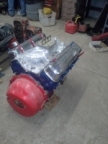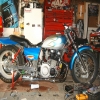- Posts: 146
- Thank you received: 5
z1 new sprocket, # of teeth?
- lewisj
-
 Topic Author
Topic Author
- Offline
- User
Less
More
12 Oct 2009 06:22 #327008
by lewisj
1973 Z1
1075cc MTC kit
Andrews 3X cams
ZRX 1200 swingarm
Vance&Hines header/ exhaust
29mm smoothbores w/pods
ZR7S 41mm Front Forks with 17" wheels
z1 new sprocket, # of teeth? was created by lewisj
I have replaced my 73 Z1 stock rear wheel with a 17" and Gs 100 swingarm. When buying a new rear sprocket for the suzuki wheel, will I need to change the number of teeth? Possibly go down a tooth or two? I want to keep it streetable and close to stock gearing.
Thanks for the help! Jim
Thanks for the help! Jim
1973 Z1
1075cc MTC kit
Andrews 3X cams
ZRX 1200 swingarm
Vance&Hines header/ exhaust
29mm smoothbores w/pods
ZR7S 41mm Front Forks with 17" wheels
Please Log in or Create an account to join the conversation.
- chance
-

- Offline
- User
- Life long biker/
Less
More
- Posts: 583
- Thank you received: 0
12 Oct 2009 07:22 - 12 Oct 2009 07:23 #327017
by chance
Replied by chance on topic z1 new sprocket, # of teeth?
This is from Z1enterprises check em out if you need help ask for JeffSaunders
Final drive ratio.
Divide the rear sprocket tooth count by the front tooth count and you have the final drive ratio. For example: 35 / 15 = 2.33:1
If you want to change your gearing, you can calculate the impact of the change before you purchase the new sprockets.
For example; your bike cruises at 60 mph / 4,000 rpm and has a final drive ratio of 2.33:1 - if you want more acceleration, putting a 37 tooth sprocket on the back and leaving 15 on the front changes the ratio to 2.47:1 (37 / 15 = 2.47:1). Divide your cruising RPM by 2.33 and multiply by 2.47. Using the example from above, 4,000 rpm becomes 4,240 rpm at 60 mph.
Changing sprocket diameter can present problems - sprocket clearance on the front limits how big you can go, and you want to avoid going too small as the tight turn wears the chain prematurely. Additionally, you can run into problems with the chain slapping the swingarm if you go too small on front and/or rear. This is something you cannot always see when the bike is static, the combination of swing arm movement over the bumps, and acceleration or deceleration cause the chain to tag the top OR bottom of the swingarm.
Changing sprocket sizes may effect chain length. As roughly 1/2 of each sprocket has chain touching it, each tooth added to stock sizes will require approximately 1/2 link of additional chain. Increasing total teeth by one or two teeth can usually be accommodated by moving the rear axle forward slightly and keeping the stock chain length - but if you start changing sprocket sizes more than one or two teeth, you will need to increase chain length. Going up four teeth will require a chain 2 links longer.
JT Sprockets has an excellent sprocket reference - see below for link.
Final drive ratio.
Divide the rear sprocket tooth count by the front tooth count and you have the final drive ratio. For example: 35 / 15 = 2.33:1
If you want to change your gearing, you can calculate the impact of the change before you purchase the new sprockets.
For example; your bike cruises at 60 mph / 4,000 rpm and has a final drive ratio of 2.33:1 - if you want more acceleration, putting a 37 tooth sprocket on the back and leaving 15 on the front changes the ratio to 2.47:1 (37 / 15 = 2.47:1). Divide your cruising RPM by 2.33 and multiply by 2.47. Using the example from above, 4,000 rpm becomes 4,240 rpm at 60 mph.
Changing sprocket diameter can present problems - sprocket clearance on the front limits how big you can go, and you want to avoid going too small as the tight turn wears the chain prematurely. Additionally, you can run into problems with the chain slapping the swingarm if you go too small on front and/or rear. This is something you cannot always see when the bike is static, the combination of swing arm movement over the bumps, and acceleration or deceleration cause the chain to tag the top OR bottom of the swingarm.
Changing sprocket sizes may effect chain length. As roughly 1/2 of each sprocket has chain touching it, each tooth added to stock sizes will require approximately 1/2 link of additional chain. Increasing total teeth by one or two teeth can usually be accommodated by moving the rear axle forward slightly and keeping the stock chain length - but if you start changing sprocket sizes more than one or two teeth, you will need to increase chain length. Going up four teeth will require a chain 2 links longer.
JT Sprockets has an excellent sprocket reference - see below for link.
Last edit: 12 Oct 2009 07:23 by chance. Reason: misspelled
Please Log in or Create an account to join the conversation.
- PLUMMEN
-

- Offline
- User
Less
More
- Posts: 8139
- Thank you received: 104
12 Oct 2009 08:18 #327026
by PLUMMEN
Still recovering,some days are better than others.
Replied by PLUMMEN on topic z1 new sprocket, # of teeth?
going to the 17" rear wheel has already afectively changed your gearing. by going with smaller diameter wheel it will spin up faster,id say dropping atleast one tooth on rear will bring you closer to stock 
Still recovering,some days are better than others.
Please Log in or Create an account to join the conversation.
- Jeff.Saunders
-

- Offline
- Vendor
12 Oct 2009 10:36 #327049
by Jeff.Saunders
This email address is being protected from spambots. You need JavaScript enabled to view it.
www.z1enterprises.com
Z1 Ent on Facebook,
Replied by Jeff.Saunders on topic z1 new sprocket, # of teeth?
You are going to have an issue getting the gearing you want using 'off the shelf' sprockets.
The Suzuki GS's used fairly large rear sprockets. For those bikes running 630 chain, the SMALLEST routinely available is 40 tooth compared to 35 tooth on the Z1 sprocket.
You can go with a 630 16 tooth on the front to help, but it still leaves you with some very aggressive gearing (it will push your RPM up around 5% before you even factor in the wheel size. This is 2.50:1 compared to 2.33:1 stock Z1 final drive ratio.
Converting to 530 is better - 18 tooth is the largest available 530 front sprocket, 43 tooth the smallest for the rear - 2.39:1 ratio.
Putting the 17" on the rear will cause roughly a 5% increase in RPM depending on the profile of the tire.
A custom aluminum sprocket for the rear would be the only way to make a big differece in the gearing.
The Suzuki GS's used fairly large rear sprockets. For those bikes running 630 chain, the SMALLEST routinely available is 40 tooth compared to 35 tooth on the Z1 sprocket.
You can go with a 630 16 tooth on the front to help, but it still leaves you with some very aggressive gearing (it will push your RPM up around 5% before you even factor in the wheel size. This is 2.50:1 compared to 2.33:1 stock Z1 final drive ratio.
Converting to 530 is better - 18 tooth is the largest available 530 front sprocket, 43 tooth the smallest for the rear - 2.39:1 ratio.
Putting the 17" on the rear will cause roughly a 5% increase in RPM depending on the profile of the tire.
A custom aluminum sprocket for the rear would be the only way to make a big differece in the gearing.
www.z1enterprises.com
Z1 Ent on Facebook,
Please Log in or Create an account to join the conversation.
- MFolks
-

- Offline
- User
Less
More
- Posts: 6650
- Thank you received: 540
12 Oct 2009 10:53 #327058
by MFolks
1982 GPZ1100 B2
General Dynamics/Convair 1983-1993
GLCM BGM-109 Tomahawk, AGM-129A Advanced Cruise Missile (ACM)
Replied by MFolks on topic z1 new sprocket, # of teeth?
Some sprocket and chain providers:
1. www.sprocketspecialists.com/
2. www.sunstar-mc.com/home.aspx
3. www.rebelgears.com/
4. www.schnitzracing.com
5. www.jtsprockets.com
6. www.pmfronline.com
1. www.sprocketspecialists.com/
2. www.sunstar-mc.com/home.aspx
3. www.rebelgears.com/
4. www.schnitzracing.com
5. www.jtsprockets.com
6. www.pmfronline.com
1982 GPZ1100 B2
General Dynamics/Convair 1983-1993
GLCM BGM-109 Tomahawk, AGM-129A Advanced Cruise Missile (ACM)
Please Log in or Create an account to join the conversation.
- lewisj
-
 Topic Author
Topic Author
- Offline
- User
Less
More
- Posts: 146
- Thank you received: 5
12 Oct 2009 12:28 #327080
by lewisj
1973 Z1
1075cc MTC kit
Andrews 3X cams
ZRX 1200 swingarm
Vance&Hines header/ exhaust
29mm smoothbores w/pods
ZR7S 41mm Front Forks with 17" wheels
Replied by lewisj on topic z1 new sprocket, # of teeth?
Thanks guys! Looks like Sproket Specialists has the Suzuki sprokets in nearly any size you wish to order for about $69.99. Sounds like a 33 or 34 tooth will get me where I want to go.
many thanks jim
many thanks jim
1973 Z1
1075cc MTC kit
Andrews 3X cams
ZRX 1200 swingarm
Vance&Hines header/ exhaust
29mm smoothbores w/pods
ZR7S 41mm Front Forks with 17" wheels
Please Log in or Create an account to join the conversation.
- Jeff.Saunders
-

- Offline
- Vendor
12 Oct 2009 12:40 #327081
by Jeff.Saunders
This email address is being protected from spambots. You need JavaScript enabled to view it.
www.z1enterprises.com
Z1 Ent on Facebook,
Replied by Jeff.Saunders on topic z1 new sprocket, # of teeth?
Let me know how you make out with sprocket specialists. We've recently crossed them off our supplier list as we had some steel front and rear sprockets on order for nearly 6 months and kept getting the run around as to when they would eventually arrive.
www.z1enterprises.com
Z1 Ent on Facebook,
Please Log in or Create an account to join the conversation.
- lewisj
-
 Topic Author
Topic Author
- Offline
- User
Less
More
- Posts: 146
- Thank you received: 5
12 Oct 2009 13:00 #327087
by lewisj
1973 Z1
1075cc MTC kit
Andrews 3X cams
ZRX 1200 swingarm
Vance&Hines header/ exhaust
29mm smoothbores w/pods
ZR7S 41mm Front Forks with 17" wheels
Replied by lewisj on topic z1 new sprocket, # of teeth?
Thanks Jeff! I will let you know if there is a hold-up or other issues. I appreciate your help as always!
Jim
Jim
1973 Z1
1075cc MTC kit
Andrews 3X cams
ZRX 1200 swingarm
Vance&Hines header/ exhaust
29mm smoothbores w/pods
ZR7S 41mm Front Forks with 17" wheels
Please Log in or Create an account to join the conversation.
- timebomb33
-

- Offline
- User
Less
More
- Posts: 4288
- Thank you received: 10
12 Oct 2009 19:02 #327163
by timebomb33
1973 z1 2-1974z1-a,2-1975z1-b dragbikes1015cc+1393cc, 1977kz1000,1978kz1000,1981kz1000j, 1997 zx-11, 2000 z12r,1428turbo nitrous pro-mod and a shit load of parts thats all for now leader sask.,CANADA
I THINK MY POWERBAND BROKE
Replied by timebomb33 on topic z1 new sprocket, # of teeth?
hey jeff have you tried rebel gears they apparently did all the one off stuff for sprocket specalties anyway at one time.
1973 z1 2-1974z1-a,2-1975z1-b dragbikes1015cc+1393cc, 1977kz1000,1978kz1000,1981kz1000j, 1997 zx-11, 2000 z12r,1428turbo nitrous pro-mod and a shit load of parts thats all for now leader sask.,CANADA
I THINK MY POWERBAND BROKE
Please Log in or Create an account to join the conversation.
- Jeff.Saunders
-

- Offline
- Vendor
12 Oct 2009 19:31 #327170
by Jeff.Saunders
This email address is being protected from spambots. You need JavaScript enabled to view it.
www.z1enterprises.com
Z1 Ent on Facebook,
Replied by Jeff.Saunders on topic z1 new sprocket, # of teeth?
We've starting buying for the company Sprocket Specialists used for most of the front sprockets - they are even making some custom cuts for us (like a 530 18 tooth conversion sprocket for the J engines 1000's and 1100's). The rears are made overseas in Taiwan. We have not been able to locate the company in Taiwan yet.
www.z1enterprises.com
Z1 Ent on Facebook,
Please Log in or Create an account to join the conversation.
- donthekawguy
-

- Offline
- User
Less
More
- Posts: 1913
- Thank you received: 8
12 Oct 2009 23:27 #327222
by donthekawguy
Rathdrum Idaho
1971 Kawasaki g3ss
1972 Yamaha R5 350
1965 Suzuki Hillbilly
1964 Yamaha 125
Replied by donthekawguy on topic z1 new sprocket, # of teeth?
I switched to a 530 chain and sprockets and I'm using the suzuki rear whel. the 430 rear sprocket is good. I thought it was going to be too big but it is sweet. Cruises nice at 4500 rpm at about 60 mph. I went on a 300 mile ride acouple of months ago and it was like riding a Goldwing. 
Rathdrum Idaho
1971 Kawasaki g3ss
1972 Yamaha R5 350
1965 Suzuki Hillbilly
1964 Yamaha 125
Please Log in or Create an account to join the conversation.